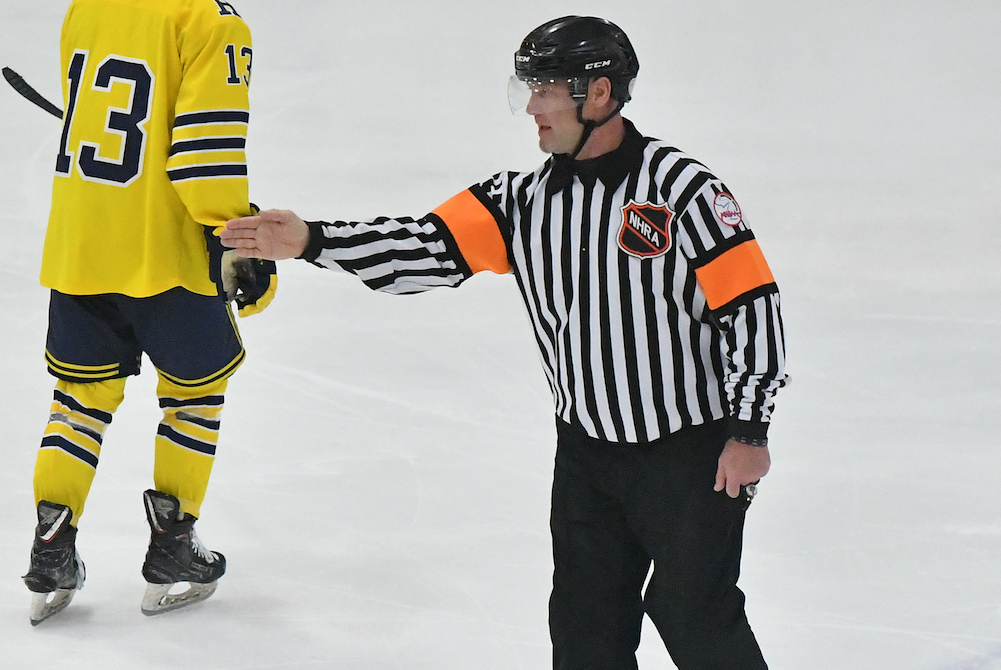
Retired NHL-er Back on Ice to Answer Call - By Making Them
By
Rob Kaminski
MHSAA benchmarks editor
March 16, 2023
The most accomplished skater on the ice during Friday’s triple-overtime MHSAA Division 1 Semifinal hockey thriller between Hartland and Brighton was not wearing the school colors of either team.
In front of a packed house at Plymouth’s USA Hockey Arena, referee Bryan Smolinski was in stripes, just like the rest of his officiating crew.
In his former life, he pulled on plenty of sweaters before lacing up the skates. That happens when one logs more than 1,000 games, tallies nearly 300 goals (274) and close to 400 assists (377) with eight teams spanning a 15-year playing career in the National Hockey League.
So, how did the 52-year-old former star player find himself on the ice last weekend as one of the referees for the pinnacle weekend of this high school season? Good question, even for the man known as “Smoke” during his playing days.
“I was working in youth development programs a few years back and reached out to some Michigan guys I had connections with about other ways to help the game,” Smolinski said. “I called Kevin May just to chat and asked, ‘Hey, how’s your reffing going?’ He said, ‘You know, we’re down a little bit,’ then said, ‘Why don’t you do it?’ I said, ‘Not a chance,’” Smolinski laughed.
Never Say Never
May persisted, imploring his friend to skate with him during a Fall league at Cranbrook in Bloomfield Hills. After eight weeks, once a week, Smolinski had a revelation.
“I’m like, ‘I’m kind of diggin’ this,’” Smolinski said “So, I did all the testing, and the educational part of it, and I really enjoyed it. I got with Danny (DiCristofaro) and his group, and he put me in as much as he could, and I really started to get my feet wet.”
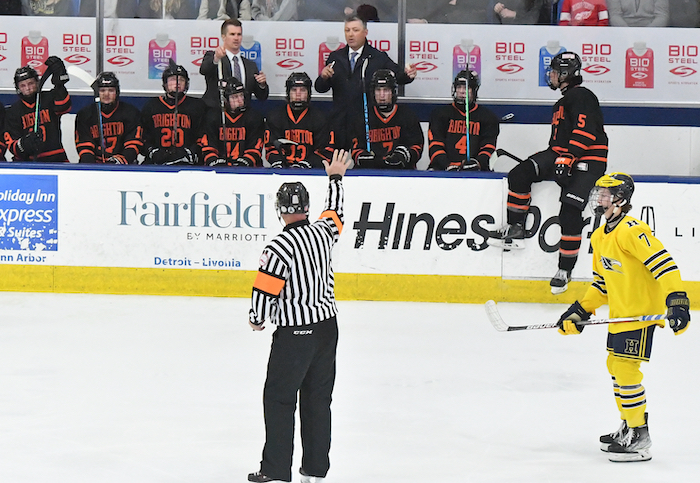 DiCristofaro is the assigner and referee-in-chief for the MHSAA’s Northeast Hockey Referees Association, and he has seen Smolinski’s growth first-hand.
DiCristofaro is the assigner and referee-in-chief for the MHSAA’s Northeast Hockey Referees Association, and he has seen Smolinski’s growth first-hand.
“Obviously he’s got great instincts and a feel for the game, along with a wealth of experience, all of which has allowed him to climb the ladder quickly,” said DiCristofaro. “It’s been a joy to watch his growth as an official.”
Fast forward to last Friday, and there were Smolinski and May sharing duties as referees during the MHSAA Semifinal with linesmen Michael Andrews and Thomas Robbins.
In between, there has been a learning curve that still continues, but the jump to officiating was not quite as daunting as his introduction to the NHL.
“I was scared to death. My first game was against Mario Lemieux. I’m in the old Boston Garden and now I’m playing against these guys and it’s their job, and they’re out there trying to make a living,” Smolinski recalled.
The emotions were not running nearly as frenzied for his first game as an MHSAA official, obviously, yet respect came in a different form.
“I couldn’t pick the puck up, I was breathing heavily; it was Kevin and me doing a two-man game in Brighton,” Smolinski recalled. “There were a few high-end kids playing, and I’m thinking, ‘I’m dying here.’ You know, there’s no training for that first time.”
What that experience did, however, was revitalize Smolinski in a new way. His playing career is well documented, not only in the NHL, but around Michigan. He enjoyed an honor-laden career at Michigan State University from 1989-93 before joining the Boston Bruins (who had drafted him three years earlier) at the end of the ’93 NHL campaign. Even after his final season, with Montreal in 2007-08, he stayed in the game via men’s leagues, or coaching his son, Max.
Smolinski and his wife, Julie, have three daughters: Ashtyn (22), Jojo (16) and Rylen (12), along with Max, whom dad coached for seven years including during a national championship run with a Little Caesars U15 team in 2019. Max, 19, is now playing collegiately at Rensselaer Polytechnic Institute.
So, for Smolinski, officiating offers a new chapter.
“Reffing brought back ... I wouldn’t say love of the game, because that’s always been there; it’s a different side of enjoying the game now. I have no horse in the race, my son’s off to college, my daughters are doing their thing; I wanted to find something new in the game,” Smolinski said. “I’ve coached, and I don’t want to do that. I found this, and I’ve stuck with it.”
Old College Ties
One of the great benefits of athletics at any level are the friendships made. For two kids who met in their first years on the MSU campus and forged a bond that lasts to this day, it’s amazing how their careers reached the pinnacle and have now come full circle.
Wes McCauley, an MSU teammate, is one of Smolinski’s best friends. After numerous years in the minor leagues, McCauley, like his friend, made it to the NHL. But McCauley made it as an official, working his first NHL game in 2003, when Smolinski was nearing the end of his playing career.
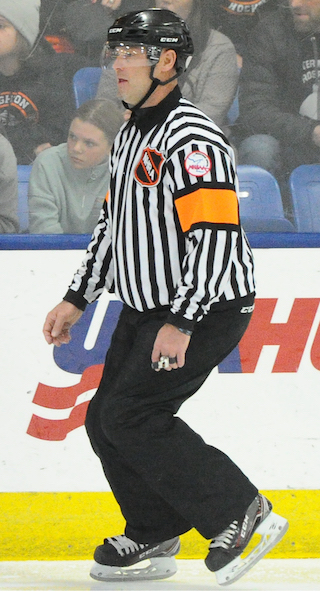 Their games lined up on just a few occasions in the NHL, and the two lobbied hard to have McCauley work Smolinski’s 1,000th career game in his final season with the Canadiens in 2007-08. The request, sadly, was denied by the league.
Their games lined up on just a few occasions in the NHL, and the two lobbied hard to have McCauley work Smolinski’s 1,000th career game in his final season with the Canadiens in 2007-08. The request, sadly, was denied by the league.
On the rare occasions when the friends did share the same ice, less than a handful by Smolinski’s count, it was McCauley who was forced to rebuff any attempts at fraternization. It’s just part of an official’s edict.
“For both of us, it was amazing; it was just great,” Smolinski said. “I’d say, ‘Hey man what’s up?’ and he says, ‘Can’t talk.’ I’m like, ‘What do you mean, we talk all the time.’ Again, he’s like, ‘Can’t talk, get away from me.’ You know, it was just business.”
McCauley then reached the 1,000-game plateau himself in 2018 and is still going strong as a regular selection for playoff duties with nine Stanley Cup Finals assignments, including last year.
So, it should have been natural for Smolinski to go to his old friend immediately for officiating pointers once he joined the ranks, right? Well, maybe not immediately.
“I talk to Wes all the time, but I actually hid it from him right out of the gate because I didn’t want to take his razzing. Eventually it got out, and he was loving it. He started sending me whistles and visors and pants,” Smolinski said, grinning. “And none of it fit, you know, because I’m older and fatter, and he’s so damn skinny. So, I still had to go out and get all new gear.”
Both Sides Now
Having been to the top of his profession, now moving to the other side of that same mountain that his friend McCauley scaled, the respect has grown for those blowing the whistle.
“The preparation for officiating is much more mental,” Smolinski said. “Way more rules oriented. You’re always trying to get away with things that you can as a player; now you have to police that.”
Smolinski has a distinct advantage.
“I know everything they’re trying to do because I’ve done it. I know where you’re going with the puck, I know what kind of breakout you’re trying to do,” Smolinski said. “I have all the instincts, now I just try to stay out of the way and not ruin their game. The most fun is watching the game develop and the ups and downs. For me to be out there and enjoy it with them, that’s the fun part.”
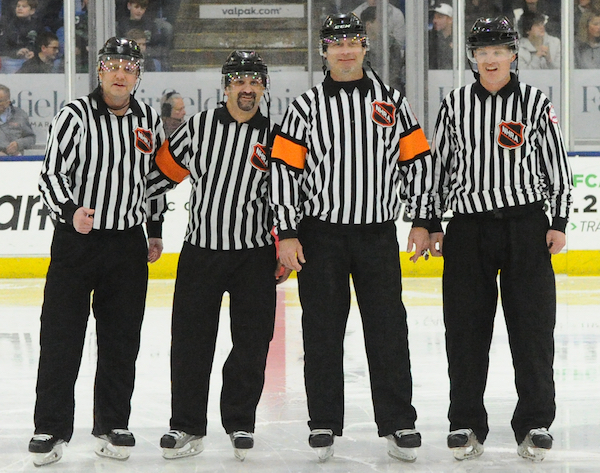 Those who have played hockey at any level have a built-in advantage should they consider the officiating avocation: the ability to skate. Unlike officiating in any other sport, skating is a prerequisite. This makes the pool limited, and almost solely composed of former players. Smolinski offers this advice.
Those who have played hockey at any level have a built-in advantage should they consider the officiating avocation: the ability to skate. Unlike officiating in any other sport, skating is a prerequisite. This makes the pool limited, and almost solely composed of former players. Smolinski offers this advice.
“I prefer sticking with high school because I think there’s more decorum, more administrative structure. Kids are playing for their schools, there’s loyalty there,” said Smolinski. “And there is more accountability. People need report to athletic directors and supervisors. Other levels can be more loosely governed, or a bit more maverick in nature. Moms and dads get involved more, coaches maybe know a little less,” said Smolinski.
He has, in fact, worked a handful of non-school games, and there’s a stark difference.
“I wanted to see what was going on, and I see it first-hand,” Smolinski said. “There are some crazy people and parents out there, and these guys are getting absolutely tortured. I’ve been tortured. There has to be a level of respect for what officials do. I think schools can rein that in a little more. All the guys I’ve met give up a lot of time and work hard because they love to do it and love the game.”
All sports need an assist from school administration and from those who once played the games to keep the officials recruitment moving in the right direction. People like Smolinski can help.
“He clearly doesn’t need to do this, and that’s what makes it so fantastic,” DiCristofaro said. “We need more people who have played – at any level – to do what he’s done and stay in the game as officials.”
Smolinski continues to promote the game in other ways as well. Currently, he is involved in the NHL’s Learn To Play initiative, which aims to inspire youth and welcome more families into the hockey community.
“We work hand-in-hand with the NHL Players Association for player development and industry growth,” Smolinski said. “Ages 5 to 9 are introduced to hockey, get head-to-toe gear and instruction, and meet some former players.”
The idea is to have fun first, which can translate into years and maybe even a lifetime in the sport. It’s a lifetime that has given Smolinski so much and continues to do so as he watches it unfold for others from his new vantage point.
PHOTOS (Top) MHSAA official Bryan Smolinski signals during Friday's Division 1 Semifinal between Brighton and Hartland. (2) Smolinski, a retired NHL standout, communicates with the Bulldogs' bench. (3) Smolinski keeps watch during game play. (4) Smolinski, third from left, with his crew: Michael Andrews, Kevin May and Thomas Robbins.
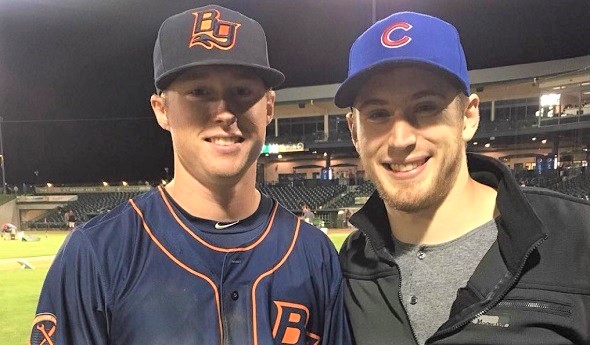
Pro Stars Cherishing St Clair Roots, Support
By
Paul Costanzo
Special for MHSAA.com
November 11, 2020
It’s been nearly 10 years since Jacob Cronenworth and Tyler Motte were teammates at St. Clair High School, but the pair still managed to energize their hometown in 2020.
 Cronenworth tied for second in the official National League Rookie of the Year voting, which was announced Monday – and won several Rookie of the Year honors from other organizations, including his fellow players – after a standout first season with the San Diego Padres.
Cronenworth tied for second in the official National League Rookie of the Year voting, which was announced Monday – and won several Rookie of the Year honors from other organizations, including his fellow players – after a standout first season with the San Diego Padres.
Motte was a key cog for the Canucks as they made a run to the Western Conference semifinals, scoring four goals and adding an assist in 17 playoff games, and earning himself a two-year contract extension in October.
And as the folks back home were reveling in that success, both were happy to have the support.
“The support of our town has been crazy throughout my career, even back when I was at Michigan,” Motte said. “When you have the support of not just your friends, family and loved ones, to have it go to an even bigger population where you grew up, that’s cool to see.”
 Motte and Cronenworth provided plenty of great memories while students in St. Clair, most notably helping the Saints win the 2011 MHSAA Division 2 baseball championship. Cronenworth was the winning pitcher in the title game, while Motte had two hits and scored what turned out to be the winning run against Grand Rapids Christian.
Motte and Cronenworth provided plenty of great memories while students in St. Clair, most notably helping the Saints win the 2011 MHSAA Division 2 baseball championship. Cronenworth was the winning pitcher in the title game, while Motte had two hits and scored what turned out to be the winning run against Grand Rapids Christian.
“Obviously, that was an incredible team,” said Cronenworth, who was a junior that season. “We only lost one game the whole year. It was just a special group of guys. We were all friends, we all played little league together. We’d all play street hockey and basketball together in the summers. It was a great way to cap off our childhood.”
That team featured 10 players who would go on to play college athletics. Two – Joel Seddon and Jared Tobey – joined Cronenworth and Motte as professional draft picks, as they were both selected in the MLB Draft. Another, Jeremy Carrell, is now the Detroit Tigers bullpen catcher.
Most of the players on the title team had been playing together since Little League, where they also had plenty of success, taking second in the state in 2006 before a handful of them came back and took third the next year. As they stayed together, the wins kept coming.
“I think at the time (2011), with that group of people, our eyes were on a state championship,” Motte said. “I was in more of a supporting role, because we had a lot of good baseball players. Just looking back, it was kind of crazy.
“Going through with those guys and how much fun we had in Little League really made the camaraderie we had in high school so much stronger. We had guys that really cared about each other, and that’s what made it really fun.”
 The 2011 Division 2 Final was Motte’s final competitive baseball game, as after his sophomore year he joined the USA Hockey National Team Development Program in Ann Arbor. He had planned to continue playing baseball while going to school at Ann Arbor Pioneer, but said that it didn’t work out.
The 2011 Division 2 Final was Motte’s final competitive baseball game, as after his sophomore year he joined the USA Hockey National Team Development Program in Ann Arbor. He had planned to continue playing baseball while going to school at Ann Arbor Pioneer, but said that it didn’t work out.
“If there was a way to go out, that’s the way to do it,” he said.
Baseball was a big part of Motte’s athletic upbringing, just like hockey was a big part of Cronenworth’s. The two had played travel hockey together locally in Port Huron, and Cronenworth continued to play the sport through high school. By that time, baseball had started to look like his path forward, but he was still a star on the ice, winning the Macomb Area Conference Red MVP.
“It was one of those things, I think Tyler wanted to play both in college, but it was a decision that we kind of had to make – I always wanted to play hockey,” Cronenworth said. “I think probably my sophomore year of high school, maybe freshman year when I got called up to the varsity in baseball, that was the turning point. But (hockey season) was huge. It just gave me a rest from baseball. When we were younger, yeah, you’re playing street hockey in the summer, but when it was baseball season, we played baseball, and when it was hockey season, we played hockey.”
Both went to University of Michigan to continue their academic and athletic careers and took winding professional paths before getting the opportunities they’re currently enjoying.
Both already have been part of multiple pro organizations. Cronenworth was dealt to San Diego after beginning his career as a Tampa Bay Rays draft pick. Motte was a Chicago Blackhawks draft selection and after his first season was traded to the Columbus Blue Jackets, who later sent him to Vancouver.
But while they may both be out west now, their biggest fans remain in St. Clair – unless you count each other.
“I got to watch him play basically every single game besides,” Cronenworth said. “He had that game where he scored two short-handed goals, and I’m in my living room at 10:30 in the morning screaming at the TV. We have a group chat with the guys we played with in high school. We’re like one big family. We grew up together.”

 Paul Costanzo served as a sportswriter at The Port Huron Times Herald from 2006-15, including three years as lead sportswriter, and prior to that as sports editor at the Hillsdale Daily News from 2005-06. He can be reached at [email protected] with story ideas for Genesee, Lapeer, St. Clair, Sanilac, Huron, Tuscola, Saginaw, Bay, Arenac, Midland and Gladwin counties.
Paul Costanzo served as a sportswriter at The Port Huron Times Herald from 2006-15, including three years as lead sportswriter, and prior to that as sports editor at the Hillsdale Daily News from 2005-06. He can be reached at [email protected] with story ideas for Genesee, Lapeer, St. Clair, Sanilac, Huron, Tuscola, Saginaw, Bay, Arenac, Midland and Gladwin counties.
PHOTOS: (Top) Former high school teammates Jacob Cronenworth (left) and Tyler Motte meet up while Cronenworth plays minor league baseball for the Bowling Green Hot Rods in 2016. (Middle) Cronenworth shows his support for Motte during the latter’s time suiting up for USA Hockey. (Below) Cronenworth holds the trophy and Motte is bottom row, second from right, as St. Clair celebrates its 2011 Division 2 baseball championship. (Photos of Cronenworth and Motte together courtesy of Tyler Motte; head shots courtesy of MLB.com and NHL.com, respectively.)

